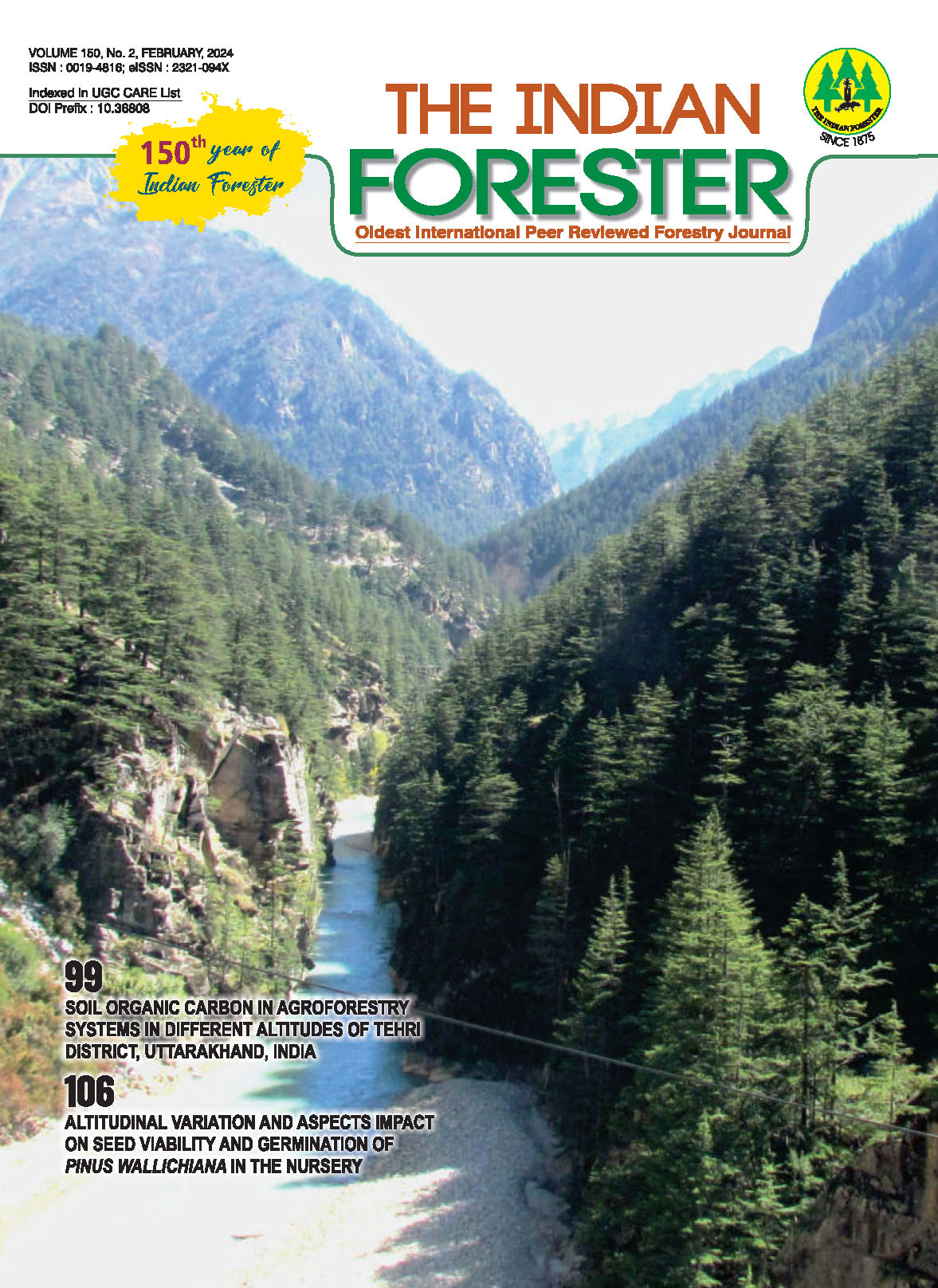Bamboo Leaves: Exploring the Nutritional and Antioxidant Profile of the New Age Functional Food in Bambusa vulgaris and Bambusa tulda
DOI:
https://doi.org/10.36808/if/2024/v150i2/169575Keywords:
Bamboo Leaves, Fodder, Functional Food, Protein, Fiber, Antioxidant.Abstract
Bamboos, which are considered beneficial for the environment, generates livelihood and provides food and fodder to humans and live stocks in many parts of the world. In the present paper leaves of two species of bamboo viz., Bambusa vulgaris Schard. ExJ.C.Welden and B. tulda Roxb., possibly a viable supplement of traditional fodder, were selected and studied for their nutritional composition and antioxidant activity using the standard methods. It is found that the leaves of these two species are good in nutritional composition especially in their protein and fiber content and possess good antioxidant properties which can ensure to be a promising alternative fodder for the ruminant livestock or wildlife during the times of food insecurity.References
Abbdewahab S.I., Ain N.M., Abdul A.B., Taha M.M.E. and Ibrahim T.T.A. (2009a). Energy-dispersive X-ray microanalysis of elements' content and antimicrobial properties of Pereskia bleo and Goniothalamus umbrosus. African Journal of Biotechnology, 8: 2375–2378
AFRIS (2008). FAO's Animal Feed Resources Information System. Available from URL: http:// www.fao.org/ag/aGa/agap/FRG/afris/index_en.htm. Accessed on 10th June 2020
Antwi-Boasiako C., Coffie G.Y. and Darkwa N.A. (2011). Proximate composition of the leaves of Bambusa ventricosa, Oxytenanthera abyssinica and two varieties of Bambusa vulgaris. Scientific Research and Essays, 6 (34): 6835-6839.
AOAC. (1990). Official methods of analysis (15th ed.) Association of Official Analytical Chemists, Washington DC, USA
Asaolu V.O., Odeyinka S.M., Akinbamijo O.O. and Sodeinde F.G. (2010). Effects of Moringaand bamboo leaves on groundnut hay utilization by West African Dwarf goats. Livestock Research for Rural Development, 22(1): 12-13.
Chen W., Luo Z., Chen F., Lu J. and Ding C. (2004). The nutrition status and nutrition diagnosis of bamboo leaves in the South of Hubei. Journal of Northeast Forestry University, 32(2): 41-44.
Chongtham N., Bisht M.S. and Haorongbam S. (2011). Nutritional properties of bamboo shoots: potential and prospects for utilization as a health food. Comprehensive Reviews in Food Science and Food Safety, 10(3): 153-168.
Dlamini L.C., Fakudze S., Makombe G.G., Muse S. and Zhu J. (2022). "Bamboo as a valuable resource and its utilization in historical and modern-day China," Bio.Resources, 17(1): 1926-1938.
Gong J., Xia D., Huang J., Ge Q., Mao J., Liu S. and Zhang Y. (2015). Functional components of bamboo shavings and bamboo leaf extracts and their antioxidant activities in vitro. Journal of medicinal food, 18(4): 453-459.
Kim S.M., Jeon J.S., Kang S.W., Kim W.R., Lee K.D. and Um B.H. (2012). Composition analysis and antioxidant activity of ojuk (Phyllostachy snigra Munro) leaf tea and shoot tea. Journal of Applied Biological Chemistry, 55(2): 95-101.
Koley T.K., Kaur C., Nagal S., Walia S. and Jaggi S. (2011). Antioxidant activity and phenolic content in genotypes of Indian jujube (Zizyphus mauritiana Lamk.). Arabian Journal of Chemistry. doi:10.1016/j.arabjc.2011.11.005 (in press)
Macwan C., Patel H.V. and Kalia K. (2010). A comparative evaluation of in vitro antioxidant properties of Bamboo Bambusa arundinacea leaves extracts. Journal of cell and tissue Research, 10(3): 2413.
Mao J.W., Yin J., Ge Q., Jiang Z.L. and Gong J.Y. (2013). In vitro antioxidant activities of polysaccharides extracted from Moso Bamboo-Leaf. International journal of bio. macromolecules, 55: 1-5.
Poudyal P. (1993). Aanalyse´ divers nutriments des feuilles de Bambusatulda, Dendrocalamus spp. Journal Am. Bamboo Soc., 10 (pp. 27).
Sadasivam S. and Manickam A. (1992). Biochemical Methods for Agricultural Sciences, p, Wiley Eastern Ltd, New Delhi, India, 187–188.
Sahoo A., Ogra R.K., Sood A. and Ahuja P.S. (2010). Nutritional evaluation of bamboo cultivars in sub-Himalayan region of India by chemical composition and in vitro ruminal fermentation. Grassland science, 56(2): 116-125.
Shang Y.F., Kim S.M. and Um B.H. (2014). Optimisation of pressurised liquid extraction of antioxidants from black bamboo leaves. Food chemistry, 154: 164-170.
Sharma B.D., Hore D.K. and Pandey G. (1992). Genetic Resources of Bamboo in the North-Eastern Region of India. Indian Journal of Forestry, 15(1): 44-51.
Singhal P., Bal L.M., Satya S., Sudhakar P. and Naik S.N. (2013). Bamboo shoots: a novel source of nutrition and medicine. Critical reviews in food science and nutrition, 53(5): 517-534.
Singhal P., Rudra S.G., Singh R.K., Satya S. and Naik S.N. (2018). Impact of drying techniques on physical quality of bamboo shoots: Implications on tribal's livelihoods. Indian Journal of Traditional Knowledge, 17(2): 353-359
Singhal P., Satya S. and Sudhakar P. (2011). Antioxidant and pharmaceutical potential of bamboo leaves. Bamboo Science and Culture, 24(1): 19-28.
Singhal P., Shukla L., Satya S. and Naik S.N. (2017b). Scientific Validation and Process Mechanism of Traditional Bamboo Shoot Fermentation by Isolation and Characterization of Lactic Acid. Current Nutrition & Food Science, 13(3): 176-181.
Singhal P., Singh R.K., Satya S. and Naik S.N. (2017a). Toxicity reduction in bamboo shoots: field survey and scientific validation of a traditional knowledge system. Culture, agriculture, food and environment, 39(2): 138-142.
Soest P.V. and Wine R.H. (1967). Use of detergents in the analysis of fibrous feeds. IV. Determination of plant cell-wall constituents. Journal of the association of official analytical chemists, 50(1): 50-55.
Thapa B., Walker D.H. and Sinclair F.L. (1997). Indigenous knowledge of the feeding value of tree fodder. Animal Feed Science Technology, 68: 37-54.
Uthayakumaran S., Newberry M., Keentok M., Stoddard F.L. and Bekes F. (2000). Basic rheology of bread dough with modified protein content and glutenin-to-gliadin ratios. Cereal Chemistry, 77(6): 744-749.
Yayota M., Nakano M., Karashima J. and Ohtani S. (2008). Forage selection by beef cows grazed on a dwarf bamboo (Pleioblastus argenteostriatus f. glaber)-dominant pasture. Grassl. Sci., 54: 33–39.
Yuan J.X. (1983). Research on the production and botanical origin of bamboo juice in Eastern China. Zhongyao tong bao (Beijing, China: 1981), 8(2): 10-12.
Zhang-Y., Wu-X-Q. and Yu-Z-Y. (2002). Comparison study on total flavonoid content and anti-free redical activity of the leaves of bamboo, Phyllostachys nigra, and Ginkgo biloba. Zhongguo-Zhong-YaoZa-Zhi., 27(4): 254-7.
Downloads
Downloads
Published
How to Cite
Issue
Section
License
Unless otherwise stated, copyright or similar rights in all materials presented on the site, including graphical images, are owned by Indian Forester.





